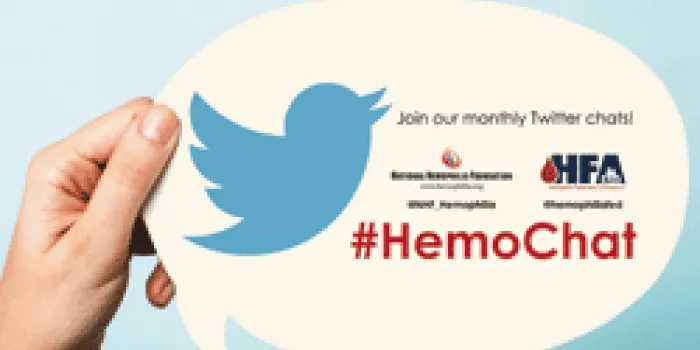Social media has long been lauded for its ability to connect people with common interests, regardless of their location. When the topic of interest is something uncommon—like a bleeding disorder—social media can provide not only a way for users to make their own personal connections, but also for national organizations and local chapters to connect with the communities they serve.On April 17, 2013, the National Hemophilia Foundation (NHF) launched its first Twitter chat, in honor of World Hemophilia Day. Twitter chats are regularly scheduled discussions, usually at the same time of day and month, on a focused topic. NHF created the hashtag #HemoChat to aggregate the discussion. The first chat attracted participants from across the US and Canada, and from as far away as Egypt. Participants shared stories of living with a bleeding disorder and what they were doing to raise awareness for World Hemophilia Day.
Since then, NHF has made HemoChats a monthly event, each focusing on a different topic. Past chats have covered school issues, inhibitors, bleeding disorders camp and insurance. Since August 2013, the Hemophilia Federation of America (HFA) has partnered with NHF in hosting the chats.
“The bleeding disorders community is small, and we wanted to make sure we reached as many people as possible with these chats,” says John Indence, vice president for marketing and communications at NHF. Co-hosting the chats with HFA ensures the widest reach possible.
Each chat lasts an hour. “We usually ask four questions, one every 5 minutes,” Indence says. The questions can serve as starting points for conversations among the participants, who trade advice and give support, including “#HemoChat” at the end of every tweet. NHF and HFA also direct chatters to resources about the topic.
HemoChats benefit the bleeding disorders community and the organization as well. “These chats are a wonderful way to demonstrate synergy among the national organizations, local chapter/member organizations, and patients living with a bleeding disorder,” says Rich Pezzillo, communications director for HFA. A recent HemoChat on the My Life, Our Future (MLOF) genotyping initiative, which featured co-hosts and MLOF partners the Puget Sound Blood Center and the American Thrombosis and Hemostasis Network, gave chatters a chance to ask detailed questions about the initiative and receive answers in real time.
The partnership between HFA and NHF gives each organization a chance to promote its own programs. There have been chats on HFA’s Annual Symposium and NHF’s Annual Meeting, and there are plans for more program-specific chats in the future.
Completed chats are compiled in Storify, an online service that allows users to aggregate online media into a coherent timeline. People who missed the chat can read the discussion and resources later.
HemoChats are held on the third Wednesday of each month at 1 p.m. ET. Follow NHF and HFA on Twitter at @NHF_Hemophilia and @hemophiliafed for announcements on future topics.

